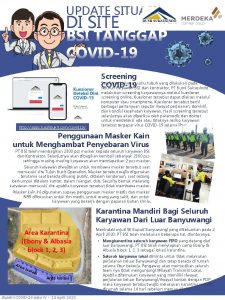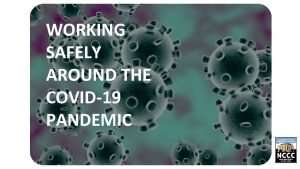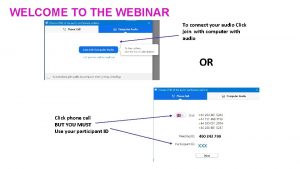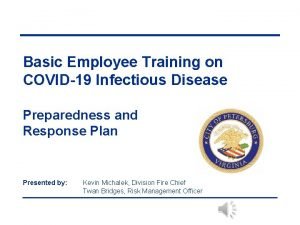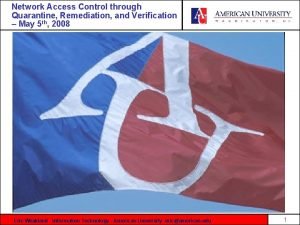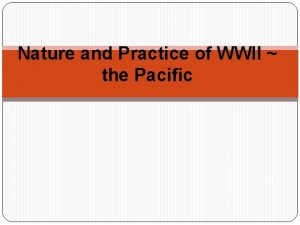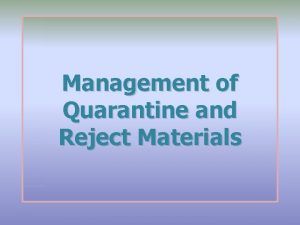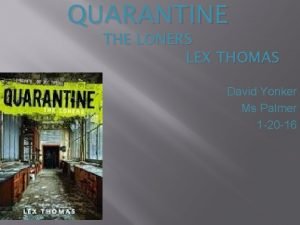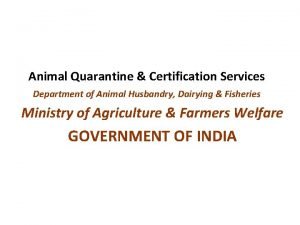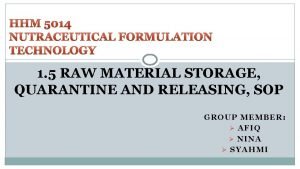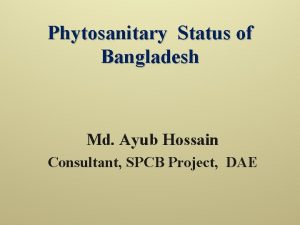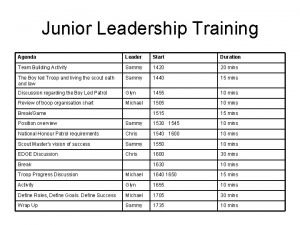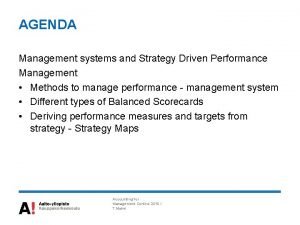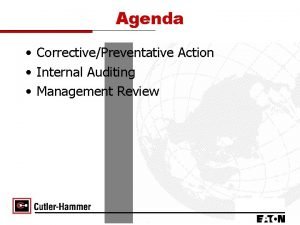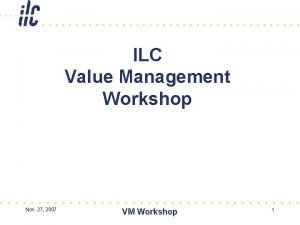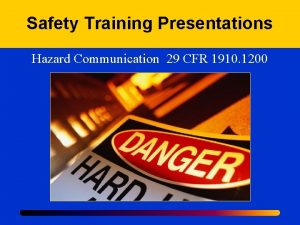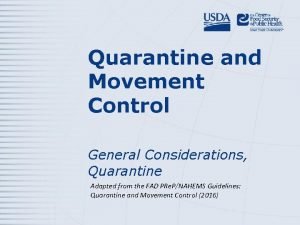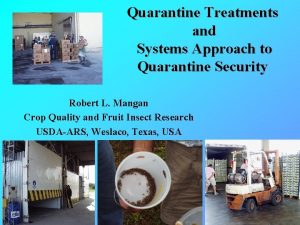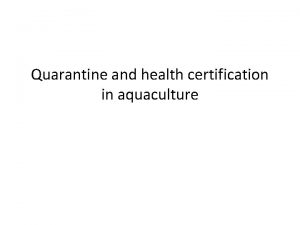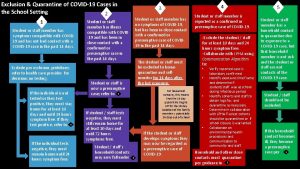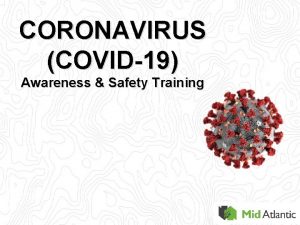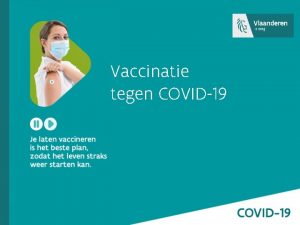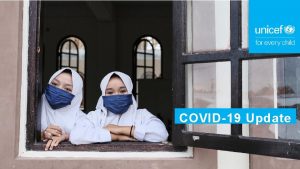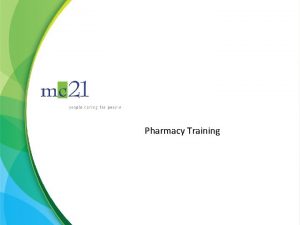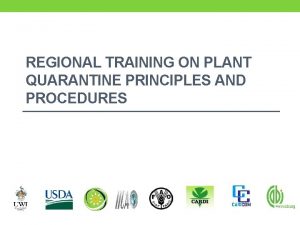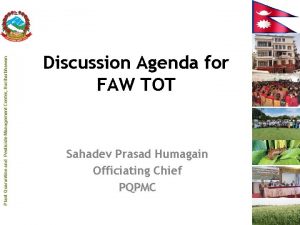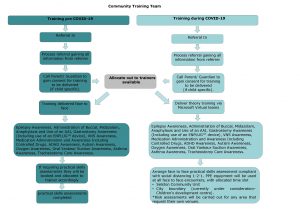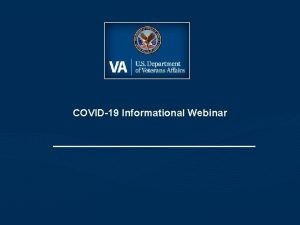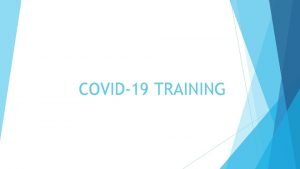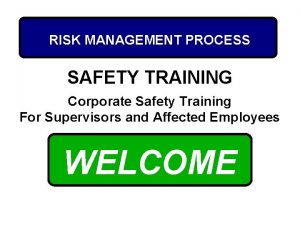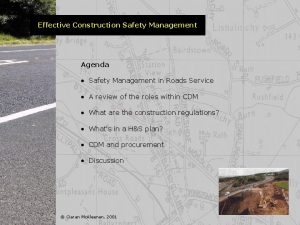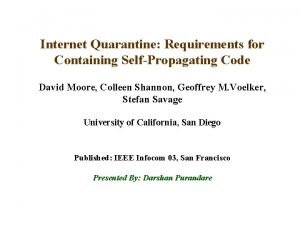Safety COVID19 MANAGEMENT SAFETY TRAINING Safety Agenda Quarantine



























- Slides: 27

Safety COVID-19 MANAGEMENT SAFETY TRAINING

Safety Agenda Quarantine & Isolation • Apple Tool • Quarantine • Isolation • Being Around Others After You Had or Likely Had COVID-19 MANAGEMENT SAFETY TRAINING Frequent Scenarios • Symptomatic Individuals • Possible Exposure • Unable to Self Certify Communication • Quarantine • Isolation Supplemental Sick Time • California Emergency Supplemental Paid Sick Leave (“SPSL”) • Los Angeles County Emergency Supplemental Paid Sick Leave (“SPSL”) Q&A • Return to Work • Safety & Social Distancing • Feeling Ill or Testing Positive Please remember this training is considered paid time

Safety COVID-19 MANAGEMENT SAFETY TRAINING QUARANTINE & ISOLATION

Safety Quarantine & Isolation CDC Apple Tool https: //www. apple. com/covid 19/ We will defer to the recommendations of the CDC Apple tool. Our training deck may differ from the online tool because it is more general in nature and not updated regularly. COVID-19 MANAGEMENT SAFETY TRAINING

Safety Quarantine & Isolation Quarantine Incident COVID-19 MANAGEMENT SAFETY TRAINING CDC Guidance (Updated May 6, 2020) If you: Then: • Recently had close contact with a person with • Quarantine: stay home, separate from others, COVID-19. monitor health, and follow directions from health department. The virus is thought to spread mainly from person Stay Home and Monitor Your Health -to-person. • Stay home until 14 days after your last Between people who are in close contact with exposure one another (within about 6 feet). • Check your temperature twice a day and Through respiratory droplets produced when watch for symptoms of COVID-19. an infected person coughs, sneezes, or talks. • If possible, stay away from people who are These droplets can land in the mouths or at higher-risk for getting very sick from noses of people who are nearby or possibly COVID-19. be inhaled into the lungs. COVID-19 may be spread by people who are not showing symptoms. It may be possible that a person can get COVID 19 by touching a surface or object that has the virus on it and then touching their own mouth, nose, or possibly their eyes. This is not thought to be the main way the virus spreads, but we are still learning more about how this virus spreads.

Safety Quarantine & Isolation COVID-19 MANAGEMENT SAFETY TRAINING Incident CDC Guidance (Updated May 6, 2020) If you: • Have been diagnosed with COVID-19; • Are waiting for test results, or; • Have cough, fever, or shortness of breath, or other symptoms of COVID-19 People with COVID-19 have had a wide range of symptoms reported. Symptoms may appear 2 -14 days after exposure to the virus. People with these symptoms may have COVID-19: • Fever or chills • Cough • Shortness of breath or difficulty breathing • Fatigue • Muscle or body aches • Headache • New loss of taste or smell • Sore throat • Congestion or runny nose • Nausea or vomiting • Diarrhea Then: • Isolate: stay home until it’s safe for them to be around others This list does not include all possible symptoms. • • • Stay home until it is safe to be around others. If you live with others, stay in a specific “sick room” or area and away from other people or animals, including pets. Use a separate bathroom, if available. Read important information about caring for yourself or someone else who is sick, including when it’s safe to end home isolation.

Safety Quarantine & Isolation Being Around Others Incident CDC Guidance (Updated May 26, 2020) If you: • Think or know you had COVID-19, and you had symptoms You can be with others after: • 3 days with no fever; and • Respiratory symptoms have improved (e. g. cough, shortness of breath); and • 10 days since symptoms first appeared COVID-19 MANAGEMENT SAFETY TRAINING 3 Days No Fever Symptoms Improved S 10 Days Since Symptoms First Appeared

Safety Quarantine & Isolation Being Around Others Incident CDC Guidance (Updated May 26, 2020) If you: • Tested positive for COVID-19 but had no symptoms If you continue to have no symptoms, you can be with others after: • 10 days have passed since test COVID-19 MANAGEMENT SAFETY TRAINING 10 Days Since Positive Test Result A

Safety Quarantine & Isolation Being Around Others Incident COVID-19 MANAGEMENT SAFETY TRAINING CDC Guidance (Updated May 26, 2020) If you: It is important to remember that anyone who has • Recently had close contact with a person with close contact with someone with COVID-19 should stay home for 14 days after exposure based on the time it takes to develop illness. 14 Days After Exposure A

Safety Quarantine & Isolation Being Around Others COVID-19 MANAGEMENT SAFETY TRAINING Incident CDC Guidance (Updated May 26, 2020) If you: • Have a weakened immune system (immunocompromised) due to a health condition or medication People with conditions that weaken their immune system might need to stay home longer than 10 days. Talk to your healthcare provider for more information. If testing is available in your community, it may be recommended by your healthcare provider. You can be with others after you receive two negative test results in a row, at least 24 hours apart. If testing is not available in your area, your doctor should work with an infectious disease expert at your local health department to determine if you are likely to spread COVID-19 to others and need to stay home longer.

Safety COVID-19 MANAGEMENT SAFETY TRAINING FREQUENT SCENARIOS

Safety Frequent Scenarios Symptomatic Individual Question CDC Guidance (Updated May 26, 2020) I’m sick but unable or don’t want to get a COVID 19 test. . . when can I work? If someone has a cough, fever, shortness of breath, or other symptoms of COVID-19 they must isolate by staying home until it’s safe for them to be around others. COVID-19 MANAGEMENT SAFETY TRAINING 3 Days No Fever Symptoms Improved S 10 Days Since Symptoms First Appeared

Safety Frequent Scenarios Possible Exposure Question CDC Guidance (Updated May 26, 2020) My roommate is showing COVID-19 symptoms and has not yet taken a test (or is waiting for test results) however I am not showing any symptoms at all. Can I work? Someone should not work if they had “close contact” with an individual with confirmed or suspected COVID-19. The timeframe for contact includes the 48 hours before the person became symptomatic. COVID-19 MANAGEMENT SAFETY TRAINING 48 hours before the close contact became symptomatic A 14 Days After Exposure

Safety Frequent Scenarios Possible Exposure Question CDC Guidance (Updated May 26, 2020) I was in close contact with a friend the other day and they tested positive for COVID afterwards… can I work? This depends on the timeframe of close contact. The timeframe for contact includes the 48 hours before the person became symptomatic. COVID-19 MANAGEMENT SAFETY TRAINING 48 hours before the close contact became symptomatic A 14 Days After Exposure

Safety Frequent Scenarios Possible Exposure Question CDC Guidance (Updated May 26, 2020) I was at a local restaurant yesterday and they just informed me an employee tested positive. . . can I work? This depends on whether “close contact” was made. According to CDC guidance, “Close contact” includes being within 6 feet of a person with confirmed or suspected COVID-19 or coming in direct contact with secretions (i. e. , sharing utensils, been coughed on) from a person with confirmed or suspected COVID-19; among others. COVID-19 MANAGEMENT SAFETY TRAINING 6 Feet A A S

Safety Frequent Scenarios Unable to Self Certify Question CDC Guidance (Updated May 26, 2020) I was at a mass gathering and I was unable to adhere to infection control practices, can the Company require me to take a COVID-19 test before returning to work? Employees that cannot Self-Certify shall be directed to leave the work site and seek medical attention and applicable testing by their health care provider. They are not to return to the work site until cleared by a medical professional in writing. If written medical clearance is not available, employees may return to the work site if they can self-certify COVID-19 MANAGEMENT SAFETY TRAINING 14 Days After Exposure A

Safety COVID-19 MANAGEMENT SAFETY TRAINING COMMUNICATIO N

Safety Communication Incident Communication Quarantine • • Recently had close contact with a person with • COVID-19 Contact your direct supervisor Contact HR to use sick time Work with leadership on modified scheduling COVID-19 MANAGEMENT SAFETY TRAINING Incident Communication Isolation • Are waiting for test results, or; • Have cough, fever, or shortness of breath, or other symptoms of COVID-19 • • Contact your direct supervisor Contact HR to use sick time Work with leadership on modified scheduling Incident Communication Isolation • Have been diagnosed with COVID-19 • • Initiate crisis management phone tree Email COVID@eurekarestaurantgroup. com and include affected employee’s name and restaurant location Work with HR to assess quarantine plan

Safety COVID-19 MANAGEMENT SAFETY TRAINING SUPPLEMENTAL SICK TIME

Safety Supplemental Sick Time California Supplemental Sick (SPSL) In addition to the leave policies outlined in the Employee Handbook Eureka! will now offer the following additional leave program for eligible employees from April 16, 2020 through the pendency of the statewide stay-at-home order issued by the State Public Health Officer. This Temporary Leave Policy is not retroactive and is not applicable to leave taken before April 16, 2020. COVID-19 MANAGEMENT SAFETY TRAINING All employees are eligible for SPSL to be taken if: • Subject to a Federal, State or local quarantine or isolation order related to COVID-19; or • Advised by a health care provider to self-quarantine or self-isolate due to concerns related to COVID-19; or • Prohibited from working by the Company due to health concerns related to the potential transmission of COVID-19. Full-time employees can take up to 80 hours of SPSL, including workers who worked or were scheduled to work, on average, at least 40 hours per week in the two weeks preceding the date they take the leave. Part-time employees with a normal weekly schedule can take up to the total number of hours they are normally scheduled to work in a two week span. Part-time employees with a variable schedule can take up to 14 times the average number of hours worked each day in the six (6) months preceding the date the worker takes the leave. If the employee has worked less than six (6) months, the calculation should be based on the entire period the individual worked for or through the Company. Employees are not required to use any other paid or unpaid leave, paid time off, or vacation time provided by the Company before the employee uses SPSL, or in lieu of SPSL. Requests should be made in ADP Workforce. Now.

Safety Supplemental Sick Time LA County Supplemental Sick (SPSL) In addition to the leave policies outlined in the Employee Handbook Eureka! will now offer the following additional leave programs for eligible employees from March 31, 2020, through December 31, 2020 under the SPSL. This Temporary Leave Policy is not retroactive and is not applicable to leave taken before March 31, 2020. The Los Angeles County SPSL covers all employees within the county and they are not provided with California SPSL. COVID-19 MANAGEMENT SAFETY TRAINING All employees are eligible for SPSL to be taken if: • A public health official or healthcare provider requires or recommends the employee isolate or self-quarantine for reasons related to COVID-19; • The employee is subject to a federal, state or local quarantine or isolation order related to COVID-19 (e. g. , the employee is at least 65 years old or has a health condition, such as heart disease, asthma, lung disease, diabetes, kidney disease, or weakened immune system); • The employee needs to care for a family member who is subject to a federal, state or local quarantine or isolation order related to COVID-19 or has been advised by a health care provider to self-quarantine related to COVID-19; or • The employee needs to provide care for a family member whose senior care provider or whose school or child care provider ceases operations in response to a public health or other public official’s recommendation. All employees who work at least 40 hours per week are classified as “full-time” under SPSL and are entitled to 80 hours of SPSL. Employees who work less than 40 hours per week are not classified as “full-time” and are entitled to the average number of hours they worked over a two week period between January 1, 2020 through April 28, 2020. Employees are not required to use any other paid or unpaid leave, paid time off, or vacation time provided by the Company before the employee uses SPSL, or in lieu of SPSL. Requests should be made in ADP Workforce. Now.

Safety COVID-19 MANAGEMENT SAFETY TRAINING Q&A

Safety Q&A Return to Work Do I have to return to work if I’m afraid of contracting COVID-19? • As a result of applicable state and local orders, all employees may return to work, provided that they are not exhibiting symptoms of COVID 19, have not been in close contact with any individual exhibiting COVID-19 symptoms or diagnosed with COVID-19 in the last fourteen days, and are able to work. If you have an underlying medical condition or other circumstances and would like to discuss the possibility of alternate work arrangements, contact Human Resources to discuss your circumstances and to discuss available options. COVID-19 MANAGEMENT SAFETY TRAINING Do I have to return to work if I am taking care of a family member who contracted COVID-19? • You may be entitled to family leave under certain leave laws for family members who have contracted COVID-19. To learn more about the leave options or alternate work arrangements that may be available, please contact Human Resources to discuss your personal circumstances. My position requires direct contact with guests or the public. How will the Company ensure I am protected? • The Company is complying and will continue to comply with all applicable Executive Orders and public health directives regarding interactions between its employees and guests or the public. Employees should utilize the face shields, face coverings, gloves, and other PPE provided by the Company or the employees’ own PPE and adhere to distancing protocols when dealing with guests or the public. Will special accommodations be made for employees who are members of a vulnerable population? • Please contact Human Resources if you are a part of a vulnerable population that has been ordered to continue staying at home as you may be entitled leave. • Employees who are over the age of 65, employees with underlying medical conditions, and pregnant employees may need special accommodations to return back to work. Contact Human Resources to discuss your circumstances and options of alternate work arrangements or accommodations to ensure your safe return to work. What should I do if I have not received my unemployment checks while I was not working? • Unemployment benefits from the state and the federal stimulus package are provided by Employment Development Department (EDD) of the State of California. Due to the extraordinary number of applicants, state agencies have been inundated by unemployment applications and there may be delays in the issuance of benefits. Contact the unemployment benefits department at the EDD at 1 -800 -300 -5616 to follow up on your application.

Safety Q&A Safety & Social Distancing COVID-19 MANAGEMENT SAFETY TRAINING What should I do if I see a co-worker, visitor, or others in the workplace not adhering to the safety and social distancing protocols? • If you feel comfortable doing so, respectfully encourage the co-worker or guest to adhere to the Company’s COVID-19 social distancing and safety protocols and policies. If the individual refuses to adhere to these protocols and policies or if you do not feel comfortable approaching the individual, we need you to immediately refer the issue to your supervisor/manager, Human Recourses, the Company’s Risk Team, or use the Company’s anonymous reporting system, Ethics. Point. Will I be retaliated against for reporting safety issues? • No. Federal and state laws prohibit an employer from engaging in retaliatory tactics, like firing, demoting, disciplining, or reducing an employee's hours, when the employee reports a workplace safety hazard. In addition, we encourage all employees to voice their concerns regarding returning to work to Human Resources. • Additionally, if you are experiencing feelings of stress, anxiety and fear, the Company offers resources for your family to receive individual, personalized support. Furthermore, all Employee Assistance Program (EAP) services that the Company provides to eligible employees are confidential and complimentary. We encourage you to use such resources during these uncertain times.

Safety Q&A Feeling Ill or Testing Positive What if I am notified that I tested positive for COVID-19 while working? • You are required to notify your Human Resources Manager, Joyce Kline, if you are experiencing symptoms of, if you have been diagnosed with, or if you have been exposed to COVID-19. Appropriate steps will be taken to ensure that your privacy will be maintained. An employee with COVID-19 poses a direct threat to the health and safety of others, and the Company is entitled to know about any such diagnosis so it can take appropriate measures. COVID-19 MANAGEMENT SAFETY TRAINING What should I do if I start feeling ill with symptoms associated with COVID-19 while at work? • You must immediately notify your direct supervisor via phone or email immediately if you begin feeling ill with COVID-19 symptoms at work. The Company will require you to go home immediately. If it is not possible for you to safely go home immediately, the Company will instruct you how and where to self-isolate until you can safely go home. What should I do if someone I live with or had close contact with in the past 14 days is suffering from COVID-19 symptoms or has been diagnosed with COVID-19? • You are required to notify Joyce Kline if someone you live with or had close contact with in the past 14 days is suffering from COVID-19 or related symptoms or has been diagnosed with COVID-19. The Company may instruct you to self-quarantine for a 14 -day period. Should I tell the co-workers I have been in direct contact with that I tested positive? • You are not obligated to do so, but you may tell co-workers that you tested positive. Whether you notify co-workers or not, the Company will investigate your direct contacts by asking you to identify all co-workers that you may have been in close contact with in the past 14 days. The Company will notify those individuals that they may have been exposed without disclosing your name. These employees will be advised to be alert to any symptoms they may experience, including fever, chills, shortness of breath, headaches, coughs, etc.

Safety Q&A Feeling Ill or Testing Positive COVID-19 MANAGEMENT SAFETY TRAINING What do I need to do to return back to work after testing positive? • If you were experiencing symptoms of COVID-19 and tested positive for COVID-19 or otherwise think you had COVID-19, you may only return back to work when: (1) you have been fever-free and seen improvement in respiratory symptoms for at least 3 days (72 hours) without the use of symptom-altering medications (e. g. , fever reducers or cough suppressants) AND (2) at least 10 days have passed since symptoms first appeared. • If you did not experience any symptoms of COVID-19 but did test positive for COVID-19, you may return to work when at least 10 days have passed since your positive test. • If diagnosed with COVID-19, you may be required to obtain documentation from your medical provider and submit it to the Company’s Risk Manager, Alma Sierra, before returning to work. We understand that medical providers may be inundated with such requests; accordingly, the Company will give you ample time to obtain such release. What should I do if I see a co-worker who I think has symptoms? • Any employee concern should be directed to your supervisor/manager. Alternatively, concerns may be raised with Human Recourses, the Company’s Risk Team, or use the Company’s anonymous reporting system, Ethics. Point. In addition, you may encourage your co-worker to contact their medical provider for guidance. You should not ask your co-worker health-related questions due to confidentiality and privacy laws. If you learn of a possible case, do not share the person’s health information with other colleagues. What will the Company do if one of the employees contracts the disease? • The Company will do everything it can to support these individuals through this difficult time. The Company is also committed to protecting its workforce and the community and will notify any individuals that have been identified as having been in contact with, or in close proximity to, any individual who has tested positive for the virus. • If an employee is confirmed to have COVID-19, the Company will inform fellow employees of their possible exposure to COVID-19 in the workplace but maintain confidentiality as required by the Americans with Disabilities Act (ADA) and other applicable laws. Will the Company require testing for employees? • The Company may require COVID-19 testing as a condition of returning to the workplace as part of its workplace strategy for infection control, while complying with all applicable laws, including EEOC guidance. However, this is dependent on the availability and reliability of such testing in sufficient quantities. The Company will notify employees of the circumstances under which testing will be required or offered, the consequences of a positive COVID-19 test or negative antibody test result, and the Company’s procedures for maintaining the results of any test as confidential.

Safety Q&A Feeling Ill or Testing Positive COVID-19 MANAGEMENT SAFETY TRAINING How do I determine if a COVID-19 illness is work related? • According to OSHA an employer must consider an injury "work-related" if an "event or exposure in the work environment either caused or contributed to the resulting condition or significantly aggravated a pre-existing injury or illness. ” However, OSHA acknowledges the difficulty in determining "whether a COVID-19 illness is work-related, especially when an employee has experienced potential exposure both in and out of the workplace. ” To aid employers in determining whether a COVID-19 illness is "work-related” and "recordable, " OSHA has articulated various factors: • The reasonableness of the employer's investigation into work-relatedness. • The evidence available to the employer. • The evidence that a COVID-19 illness was contracted at work. • There is no clear rule to determine if an employee’s contraction of COVID-19 is "work-related” therefore Eureka! will notify the work comp carrier through Med. Cor anytime there is a suspected work-related COVID-19 illness and defer to the judgement of nurse triage and associated insurance investigation.
 Http//apps.tujuhbukit.com/covid19
Http//apps.tujuhbukit.com/covid19 Do if you covid19
Do if you covid19 Covid19 athome rapid what know
Covid19 athome rapid what know What do if test positive covid19
What do if test positive covid19 Vaksin covid19
Vaksin covid19 Nac remediation
Nac remediation Fdrs quarantine speech
Fdrs quarantine speech Warehouse quarantine area
Warehouse quarantine area Quarantine the loners summary
Quarantine the loners summary Spectrum dmca quarantine
Spectrum dmca quarantine Animal quarantine and certification service
Animal quarantine and certification service Quarantine includes storage of
Quarantine includes storage of India plant quarantine
India plant quarantine Phytosanitary certificate bangladesh
Phytosanitary certificate bangladesh Food laws and regulations in pakistan pdf
Food laws and regulations in pakistan pdf Agenda sistemica y agenda institucional
Agenda sistemica y agenda institucional Safety care certification
Safety care certification Leadership training agenda
Leadership training agenda Agenda management systems
Agenda management systems Management review agenda
Management review agenda Value management workshop agenda
Value management workshop agenda Training is expensive without training it is more expensive
Training is expensive without training it is more expensive Perbedaan on the job training dan off the job training
Perbedaan on the job training dan off the job training Aggression replacement training facilitator training
Aggression replacement training facilitator training Top management middle management first line management
Top management middle management first line management Top management middle management first line management
Top management middle management first line management Top level management
Top level management 29 cfr 1910 osha 178
29 cfr 1910 osha 178
